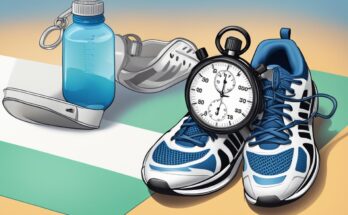When it comes to running, one of the most common questions asked is how fast should one run each day. The answer to this question is not straightforward and varies depending on several factors such as the individual’s fitness level, goals, and overall health. While some runners may strive to run faster every day, others may prefer a slower pace that allows them to go the distance.
For those who are new to running or exercise in general, it is important to start slow and gradually increase the intensity and duration of their runs. This helps prevent injury and allows the body to adapt to the new demands being placed on it. Additionally, running at a comfortable pace can help improve cardiovascular health and overall fitness levels. However, experienced runners who have specific goals such as improving their race times may need to incorporate speed work and interval training into their routine to achieve their desired results.
Determining Your Running Pace
Determining your running pace is essential to achieving your fitness goals. Whether you are a beginner or an experienced runner, understanding your running pace will help you to avoid injuries and make progress in your training. Here are some factors that affect your running pace:
Factors Affecting Running Pace
Age
Age is a significant factor that affects running pace. As people age, their bodies change, and their physical abilities decline. Older runners may find it challenging to maintain their pace, and they may need to adjust their training accordingly.
Training
Training is another critical factor that affects running pace. Runners who train regularly and consistently are more likely to maintain a steady pace. Proper training includes a balance of distance, speed, and rest.
Form
Form is also essential to running pace. Runners who have good form are more likely to maintain their pace and avoid injuries. Proper form includes maintaining an upright posture, keeping the arms relaxed, and landing on the midfoot.
Distance
The distance you run also affects your running pace. The longer the distance, the slower your pace should be. It is essential to pace yourself properly to avoid fatigue and injuries.
Rest
Rest is crucial to maintaining a consistent running pace. Runners who do not get enough rest are more likely to experience fatigue and injuries. Proper rest includes getting enough sleep, taking rest days, and avoiding overtraining.
Health
Health is another factor that affects running pace. Runners who are in good health are more likely to maintain a steady pace. Proper nutrition, hydration, and exercise are essential to good health.
In conclusion, understanding your running pace is crucial to achieving your fitness goals. By considering the factors that affect your running pace, you can adjust your training accordingly and avoid injuries.
The Importance of Rest and Recovery
Rest and recovery are crucial components of any exercise routine, especially when it comes to running. While it may be tempting to push yourself to run every day, doing so can actually be counterproductive. In this section, we’ll explore the benefits of rest days and how they can help you achieve your running goals.
The Benefits of Rest Days
Rest days allow your body to recover and repair itself after a workout. This is especially important when it comes to running, as the repetitive impact can put a lot of stress on your joints and muscles. By taking a day off from running, you give your body a chance to heal any micro-tears in your muscles and reduce inflammation.
In addition to physical benefits, rest days also provide mental benefits. Running every day can be mentally exhausting, leading to burnout and a lack of motivation. Taking a day off can help you recharge and come back to your workouts feeling refreshed and energized.
Rest days also give you the opportunity to focus on other aspects of your fitness routine. Strength training, swimming, and walking are all great options for cross-training on rest days. These activities can help improve your overall endurance and fitness level, while also giving your running muscles a break.
Finally, rest days can help prevent injuries. Overuse injuries are common in runners who don’t take enough time to rest and recover. By incorporating rest days into your routine, you can reduce your risk of injury and stay healthy and injury-free.
In summary, rest days are an essential part of any running routine. They allow your body to recover and repair itself, provide mental benefits, and help prevent injuries. By taking a day off from running and focusing on other aspects of your fitness routine, you can improve your overall endurance and fitness level while staying healthy and injury-free.
Improving Running Performance
To improve running performance, there are several factors to consider. Increasing mileage, incorporating speed work, and cross-training are three key strategies that can help runners reach their goals.
Increasing Mileage
Gradually increasing mileage is a common strategy for improving running performance. This can be done by adding an extra mile or two to a weekly long run, or by adding an additional day of running to a weekly schedule. However, it is important to avoid increasing mileage too quickly, as this can increase the risk of injury.
Incorporating Speed Work
Speed work involves running at a faster pace than usual for short periods of time. This can help improve running economy and increase overall speed. Examples of speed work include intervals, fartlek runs, and tempo runs. It is important to gradually incorporate speed work into a training plan to avoid overexertion and injury.
Cross-Training
Cross-training involves engaging in other forms of exercise to supplement running. This can include cycling, swimming, or strength training. Cross-training can help improve overall fitness level and reduce the risk of injury by strengthening muscles that may not be used as much during running.
In addition to these strategies, it is important to pay attention to factors such as sleep, fatigue, and intensity of workouts. It is also important to incorporate long runs and vary training distances to prepare for races such as 5k, 10k, and half marathons. By following these strategies, runners can improve their performance and enjoy the many health benefits of running.
Preventing Running Injuries
Running can be an excellent way to stay healthy and fit, but it can also lead to injuries if not done correctly. Here are some tips to help prevent running injuries.
Common Running Injuries
Shin Splints
Shin splints are a common injury for runners, especially those who are new to running or who have increased their mileage too quickly. They are caused by inflammation of the muscles, tendons, and bone tissue in the shin.
To prevent shin splints, it is important to start slowly and gradually increase mileage. Runners should also wear proper shoes and make sure they are running on a soft surface.
Stress Fractures
Stress fractures are small cracks in the bone that can occur from overuse. They are a common injury for runners, especially those who run on hard surfaces or who have poor running form.
To prevent stress fractures, runners should make sure they are wearing proper shoes and running on a soft surface. They should also gradually increase mileage and incorporate strength training exercises into their routine.
Plantar Fasciitis
Plantar fasciitis is a common injury for runners, especially those who have flat feet or high arches. It is caused by inflammation of the tissue that connects the heel bone to the toes.
To prevent plantar fasciitis, runners should wear proper shoes with good arch support. They should also stretch their feet and calves before and after running.
IT Band Syndrome
IT band syndrome is a common injury for runners, especially those who run long distances. It is caused by inflammation of the iliotibial band, which runs from the hip to the knee.
To prevent IT band syndrome, runners should make sure they are wearing proper shoes and running on a soft surface. They should also stretch their IT band before and after running.
Runner’s Knee
Runner’s knee is a common injury for runners, especially those who run on hard surfaces or who have poor running form. It is caused by inflammation of the cartilage under the kneecap.
To prevent runner’s knee, runners should make sure they are wearing proper shoes and running on a soft surface. They should also incorporate strength training exercises into their routine.
In addition to these tips, runners should also make sure they are getting enough rest, eating a healthy diet, and incorporating variety into their running routine. Elite runners often incorporate speed work and tempo runs into their routine, but it is important to gradually increase intensity to avoid overuse injuries.
Yoga can also be a great way to prevent running injuries by improving flexibility and balance. Finally, runners should make sure they are using proper running technique and monitoring their pace per mile to avoid overtraining and injury.
By following these tips, runners can help prevent injuries and enjoy a healthy, active lifestyle.
Choosing the Right Running Gear
When it comes to running, having the right gear can make all the difference. Here are a few things to consider when choosing the right gear for your daily runs.
Running Shoes
The most important piece of gear for any runner is a good pair of running shoes. Running shoes provide support, cushioning, and protection for your feet, reducing the risk of injury. When choosing a pair of running shoes, consider the following:
- Fit: Make sure the shoes fit well and are comfortable. They should not be too tight or too loose.
- Arch support: Look for shoes that provide adequate arch support for your foot type.
- Cushioning: Choose shoes with enough cushioning to absorb impact and reduce stress on your joints.
- Breathability: Opt for shoes made with breathable materials to keep your feet cool and dry.
Warm-Up
Before starting any run, it’s important to properly warm up your muscles to prevent injury and improve performance. Consider incorporating the following into your warm-up routine:
- Dynamic stretching: Perform dynamic stretches that involve movement, such as leg swings and high knees.
- Light jogging: Start with a slow jog to gradually increase your heart rate and warm up your muscles.
- Bodyweight exercises: Incorporate bodyweight exercises such as lunges and squats to activate your muscles.
Stretching
Stretching after a run can help prevent muscle soreness and improve flexibility. Here are a few tips for stretching after a run:
- Static stretching: Perform static stretches that involve holding a stretch for 15-30 seconds, such as hamstring stretches and quad stretches.
- Focus on problem areas: Pay extra attention to areas that tend to be tight or sore, such as the calves and hip flexors.
- Don’t overdo it: Be gentle with your stretches and avoid pushing yourself too hard.
By choosing the right running gear and incorporating a proper warm-up and stretching routine, runners can reduce the risk of injury and improve their performance.
Maintaining Consistency in Your Running Routine
Consistency is key when it comes to running. It’s important to maintain a regular running routine to improve your fitness and reach your goals. Here are some tips to help you maintain consistency in your running routine.
Weekly Training Schedule
Creating a weekly training schedule is a great way to maintain consistency in your running routine. This schedule should include the days you plan to run, the distance you plan to cover, and the type of run you plan to do (e.g. tempo run, easy run, long run). It’s important to be realistic when creating your schedule and to adjust it as needed.
Run Streaks
Run streaks can be a great way to maintain consistency in your running routine. A run streak involves running at least one mile every day for a designated period of time. This can help you stay motivated and committed to your running routine. However, it’s important to listen to your body and take rest days when needed to avoid burnout.
Frequency
Frequency is another important factor in maintaining consistency in your running routine. It’s recommended to run at least three to four times per week to see improvements in fitness. However, experienced runners may run more frequently. It’s important to find a frequency that works for you and your schedule.
Tempo Runs and Easy Runs
Incorporating tempo runs and easy runs into your weekly training schedule can also help maintain consistency. Tempo runs involve running at a faster pace for a designated period of time, while easy runs are done at a slower pace to allow for recovery. Both types of runs are important for improving fitness and preventing burnout.
Lifting and Running Workouts
In addition to running, incorporating lifting and running workouts into your routine can also help maintain consistency. Lifting can help improve strength and prevent injury, while running workouts can help improve speed and endurance. It’s important to find a balance between running, lifting, and other workouts to avoid overtraining.
Long Runs
Long runs are an important part of any running routine, but it’s important to gradually increase the distance to avoid injury and burnout. It’s recommended to increase your long run distance by no more than 10% each week.
Maintaining consistency in your running routine takes effort and dedication, but it’s worth it to see improvements in fitness and reach your goals. By creating a weekly training schedule, incorporating run streaks, finding a frequency that works for you, and balancing tempo runs, easy runs, lifting, and running workouts, you can maintain consistency and improve your running performance.
The Benefits of Running for Your Overall Health
Regular physical activity is essential for maintaining good health, and running is one of the most effective exercises for improving overall fitness. Running can provide numerous benefits for both physical and mental health.
Physical Health Benefits
Running is a form of aerobic exercise that can help improve cardiovascular health. It can increase the heart rate, strengthen the heart muscle, and improve blood circulation. Running can also help maintain healthy body weight, reduce the risk of chronic diseases such as diabetes and heart disease, and improve bone density.
In addition to these benefits, running can also help improve endurance and stamina. Regular running can lead to physiological changes in the body, such as improved oxygen uptake and better muscle adaptation, which can help individuals run longer distances and at faster paces.
Mental Health Benefits
Running can also provide numerous mental health benefits. It has been shown to have a positive impact on mood and can help reduce symptoms of depression and anxiety. Running can also help individuals manage stress and improve overall mental well-being.
Furthermore, running can provide a sense of accomplishment and boost self-esteem. Setting and achieving running goals, such as completing a half-marathon, can provide a sense of purpose and motivation.
Conclusion
Overall, running is an excellent form of physical activity that can provide numerous benefits for both physical and mental health. It is important to remember to incorporate rest and recovery into a running routine to avoid injury and burnout. By regularly engaging in running, individuals can improve their overall health and well-being.
Staying Safe While Running
Running is a great way to stay fit and healthy, but it’s important to take precautions to ensure your safety while doing so. Here are some tips to help you stay safe while running:
Safety Tips
- Plan your route: Before you head out for a run, plan your route ahead of time. Choose well-lit, populated areas where you feel safe. Avoid running in isolated areas and stick to familiar routes.
- Wear reflective clothing: If you’re running in low-light conditions, wear reflective clothing so that you’re visible to drivers and other pedestrians.
- Stay hydrated: Make sure you drink plenty of water before, during, and after your run to stay hydrated. Dehydration can cause stress on the body, so it’s important to stay hydrated.
- Run with a buddy: Running with a friend can be a great way to stay safe and motivated. If you can’t find a running buddy, consider joining a local running group.
- Be aware of your surroundings: Stay alert and aware of your surroundings while running. Keep an eye out for any potential hazards, such as uneven pavement or obstacles in your path.
- Carry identification: Always carry some form of identification with you while running. This can be a driver’s license, a health insurance card, or an ID tag on your shoe.
- Avoid running near pools: If you’re running near a pool, be sure to stay a safe distance away. Wet surfaces can be slippery and can pose a danger to runners.
By following these safety tips, you can help ensure a safe and enjoyable running experience.




